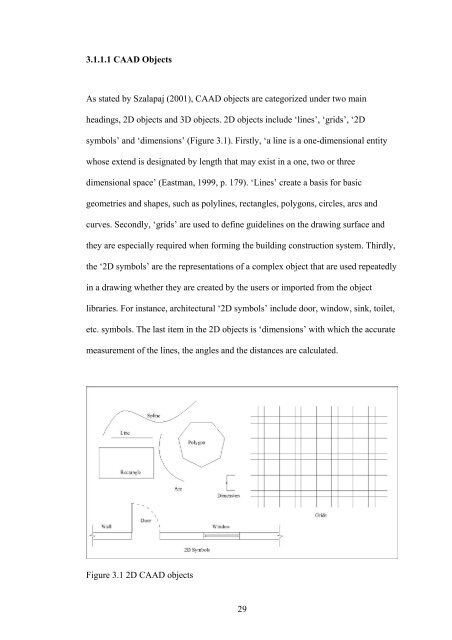critical analysis of the absence of interior - Bilkent University
critical analysis of the absence of interior - Bilkent University
critical analysis of the absence of interior - Bilkent University
Create successful ePaper yourself
Turn your PDF publications into a flip-book with our unique Google optimized e-Paper software.
3.1.1.1 CAAD Objects<br />
As stated by Szalapaj (2001), CAAD objects are categorized under two main<br />
headings, 2D objects and 3D objects. 2D objects include ‘lines’, ‘grids’, ‘2D<br />
symbols’ and ‘dimensions’ (Figure 3.1). Firstly, ‘a line is a one-dimensional entity<br />
whose extend is designated by length that may exist in a one, two or three<br />
dimensional space’ (Eastman, 1999, p. 179). ‘Lines’ create a basis for basic<br />
geometries and shapes, such as polylines, rectangles, polygons, circles, arcs and<br />
curves. Secondly, ‘grids’ are used to define guidelines on <strong>the</strong> drawing surface and<br />
<strong>the</strong>y are especially required when forming <strong>the</strong> building construction system. Thirdly,<br />
<strong>the</strong> ‘2D symbols’ are <strong>the</strong> representations <strong>of</strong> a complex object that are used repeatedly<br />
in a drawing whe<strong>the</strong>r <strong>the</strong>y are created by <strong>the</strong> users or imported from <strong>the</strong> object<br />
libraries. For instance, architectural ‘2D symbols’ include door, window, sink, toilet,<br />
etc. symbols. The last item in <strong>the</strong> 2D objects is ‘dimensions’ with which <strong>the</strong> accurate<br />
measurement <strong>of</strong> <strong>the</strong> lines, <strong>the</strong> angles and <strong>the</strong> distances are calculated.<br />
Figure 3.1 2D CAAD objects<br />
29
















